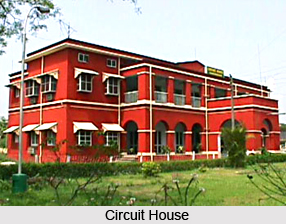Monuments in Chinsura offer a suitable opportunity for those who are interested in the history of some of the famous architectures of pre-independent India. Situated at a distance of six miles to the south of Hooghly the former Dutch enclave of Chinsura was founded in the earlier parts of the seventeenth century and was held until 1825, when it was ceded in part exchange for English possessions in Sumatra and a cash payment of one hundred thousand pounds. On acquisition by the British it became a major military centre for the East India Company and a reception area for troops which arrived newly from England. In the year 1871, the military station was given up, but large blocks of early nineteenth century barracks and quarters still remain to tell the saga of the past.
The place is intimately linked to the lives and works of some of the famous personalities like the great poet Rabindranath Tagore and Kazi Nazrul Islam and Bankim Chandra Chatterjee. The most prominent things to see in Chinsura are the Fort Gustavus, Bandemataram House, Octagonal Dutch Church, Imambara, Circuit House, Shandeswara Temple, Anna Maria Tomb, Rabindra Bhavan and Mahisasurmardini Temple.
 The Old Dutch Church and former Government House are located to the north of the river at Chinsura in West Bengal. The octagonal Church is alleged to have been constructed as early as 1678 by the Dutch Governor, but most of the existing fabric was made by Sir G. L. Vernet in the year 1767. Vernet was a former page of Louis XV. The steeple and chime clock were the gift of Mr. Sichterman and were erected in the year 1774. In 1824 the interior was adapted to suit the Anglican liturgy. It is now used as a biology laboratory attached to the local college. To the west, the Old cemetery is situated, which bears a number of early Dutch tombs enriched with crests and armorial devices, the oldest from 1662.
The Old Dutch Church and former Government House are located to the north of the river at Chinsura in West Bengal. The octagonal Church is alleged to have been constructed as early as 1678 by the Dutch Governor, but most of the existing fabric was made by Sir G. L. Vernet in the year 1767. Vernet was a former page of Louis XV. The steeple and chime clock were the gift of Mr. Sichterman and were erected in the year 1774. In 1824 the interior was adapted to suit the Anglican liturgy. It is now used as a biology laboratory attached to the local college. To the west, the Old cemetery is situated, which bears a number of early Dutch tombs enriched with crests and armorial devices, the oldest from 1662.
The Armenian Church of St John the Baptist is one of the notable historical monuments at Chinsura in the Hooghly district. It was erected by Margar Johannes in the year 1695, and completed two years later. The early tombs in the churchyard, which date from the year 1697, include that of the father of the builder. The prominent steeple was added in the earlier parts of the nineteenth century. To the south of the former Dutch Church is Hooghly College which was founded by a private benefactor in the year 1836, in a house constructed by General Perron, the French general who surrendered to Lord Lake in the war with Scindia of 1803. The house is a fine example of Anglo-Indian Palladian architecture and the town, a good example of an early nineteenth century military cantonment.



















